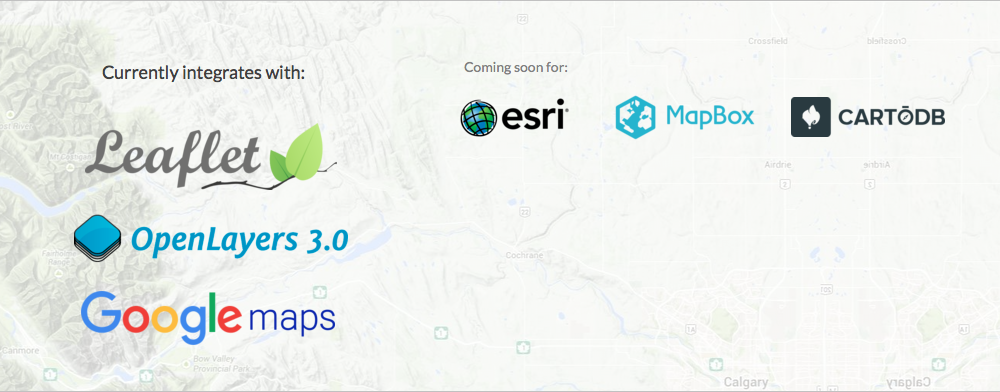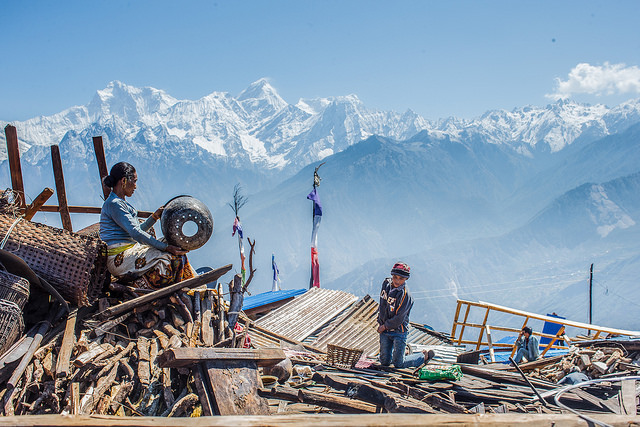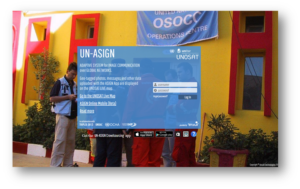The spatial community is full of amazing people. One of the biggest perks of being a geogeek is getting to share your enthusiasm and crazy love for everything geo with like-minded people. Sometime earlier, I had the opportunity to have an really interesting (and insightful) conversation with Will Cadell, the CEO of Sparkgeo.
Will and his team are the guys behind Maptiks – an google analytics for our web maps and here’s what he had to say about Maptiks, the future of web map analytics and on becoming a geo-entrepreneur.
The tag line for Maptiks is a very catchy “It’s like Google Analytics for your web map!”. Could you tell us more about Maptiks?
Our central vision is to bring web style analytics to online maps. It’s funny, I get the sense that until recently many developers have been just happy to get their map actually working; the thought of adding analytics was a distant concern. Well, now we have a plethora of tools for building amazing web maps. At Sparkgeo we felt that without an ability to actually measure a map’s performance, developers were being needlessly restricted.
When we say Maptiks is like Google Analytics for your web map, we mean we want you to be able to easily implement a robust, geographic analytics platform directly into your map with minimal effort. Its really just a couple of lines in your index.html for the vast majority of use cases.
Maptiks is designed to help map developers build better maps by applying analytics. What we really mean here is that we provide the tools to let a map developer experiment with, for example, different iconographies then determine if the red icon drives more conversions / activities than the blue icon.
That idea gets to the nub of the issue presently – Maps should convert. Conversion in a web-sense means that a particular goal has been met by a website. Well, maps should also be tasked with goals, whether that be a click on a feature, a routing activity requested or a geocoding activity. A web map should be undertaking a purposeful activity and we should be able to identify how good the map is at completing that task: conversions.
Presently we are building out our family of mapping environments and are very excited to be adding the ESRI JavaScript API as this article goes to press.
The biggest companies in tech are taking on huge projects that require geospatial solutions and of course maps are a key part of that.
The future for geospatial is exceedingly bright. I think that GIS is in the midst of a bit of a shift. Maps and GIS as a whole, are becoming much more important to a lot of industries. We are seeing a multitude of different organisations now facing some big and interesting geospatial problems, not just the military or government agencies. The biggest companies in tech are taking on huge projects that require geospatial solutions and of course maps are a key part of that. Maptiks is going to be there to provide analytics for those maps.
In some sense, maps are art forms. How does machine learning (map analytics) help decode and build better maps? or answer the question “What makes a good map?”
Maps are the intersection of art, science and people. Maptiks provides an interesting opportunity to cartographic web artists to identify and study how altering and managing the user experience can make a map more or less engaging. But maps in general have an engaging effect; maps can immerse people in data in a unique and understandable way. This subject has been written about for centuries, but I would suggest that a map provides a window into the imagination. An opportunity to wonder. Whilst against that backdrop “analytics” can seem somewhat perfunctory, in reality they have their own valuable insights. Those insights can indicate if a user is engaged in an experience, or if a user is distracted. For instance if I build a realty map, and my purpose is to help people discover properties of interest, then having them get lost exploring Yosemite Valley is problematic, (even though Yosemite is quite beautiful) . However, if the purpose of my map is to build a wondrous exposition on Yosemite and its natural history, then users appearing to ‘get lost’ in the map is the perfect experience.
Machine learning is very interesting; we certainly have plans to start looking harder at the opportunities this technology presents as we move from our presently descriptive analytics to a more prescriptive set of metrics. In essence we hope to be able to determine the key features of different mapping experiences based on what we can determine as good and bad user experiences and what a map’s intended purpose was. This may sound somewhat theoretical but the opportunity is very tangible; we will be able to determine things like the optimal base cartographies for real estate, or the optimal zoom levels for store locators. As we know removing click barriers from users encourages discovery.
In the podcast with VerySpatial, you mentioned something to the tune of “Web mapping is no longer the domain of the GIS folks alone”, do you think that analytics are going to be the driving force behind cartography in the future?
I think analytics will be a driving force. The main driving forces will be opportunity, demand and innovation, but to determine the effectiveness of any part of a value chain it needs to be fully understood; to do that you need analytics.
In terms of the domain of web mapping, think about the last half decade of geospatial web: Google, Esri & Microsoft. Today we have seen the market diversify to Apple, Mapbox, CartoDB, Uber, and few consider that Facebook and most automotive companies also have stakes in this game. In addition we have a plethora of open source tools which have helped to build the successes of a number of the above companies; technologies including PostGIS, Leaflet, OpenLayers, Mapnik. The geospatial web is becoming a busy sandbox.
You know, when Google Analytics first came out as Urchin, the only people building websites were web development agencies and some really good full-stack web developers who were building their own projects. But now, you can download a wordpress template, build drag and drop sites in less than an hour. On release the first thing you want to know is “what’s my traffic like, which pages are most popular?” I think, it’s going to be the same for web maps. Maptiks will be there to provide the detailed metrics on real map interaction the community will need to continually get better.

Web analytics for your maps (Image courtesy Maptiks)
Google Maps, Leaflet, OpenLayers 3.0 are already supported and you are planning to support Esri, CartoDB, Mapbox. How big is your team again! 😉
Ha! We’ll be releasing our Esri client library imminently, it will integrate with Esri’s Javascript API and Esri Leaflet.
We’re just six people right now. Three of our developers built Maptiks over the course of a year and we’ve added a few team members since then to help us build the product out and attract users. We’ve done this while managing a pretty full & exciting consulting workload.
The team hopes to get Mapbox and CartoDB libraries done in our next development cycle. We already support Leaflet, and both mapbox.js and cartodb.js are flavours of Leaflet, so the magic will be in how we interpret vector tiles. We’ve had a lot of user requests for those libraries and are excited to commit to full implementations.
Is Maptiks an enterprise tool or do you have (pricing) options for GeoGeeks to play around and improve their private maps as well?
It’s not just an enterprise tool. We’re certified geogeeks ourselves and we kind of built this to help the open source web map development community. So we want to make it as accessible to everyone who’s tinkering or building web maps for themselves. We have a FREE Plan that lets you track up to 5 maps. A developer plan that lets you track more maps for $39/month (USD) with unlimited historical data. And an Enterprise Plan that’s tailored to media companies and GIS solutions providers that get tens of thousands map loads per month.
We’re certified geogeeks ourselves and we kind of built this to help the open source web map development community.
Our costs are server-side so we do have to charge something. But if you contact our team, we can hook up any developer with an awesome discount. In fact, contact our growth guy Julien, at julien@maptiks.com and he’ll hook any web map developers with a FREE account or a paid Developer Plan at 50% off. Just put “Geoawesomeness” in the title of the email and he’ll get you setup.
As CEO what’s your vision for the next year(s)? What is the crystal ball showing you?
This is a tough question; unfortunately, I’ve lost my crystal ball.
This is what I do know: Geospatial is in a crazy growth phase. Literally everyday something interesting happens in our “niche” industry. Companies across the web and across the industrial complex are looking at mapping and thinking, “Wow we can do things way better with geospatial on the web”. I am sorry to say we are becoming less niche, but with that has come more investment, more innovation, and more companies solving more interesting problems. Bubbles aside, I can only imagine this continuing.
What does this mean for Maptiks? To be honest, I’m not totally sure. That’s what’s so fun about what we’re doing. I do know that we’re solving a real problem for people right now and we’re spending a lot of time talking to our customers to see what else we can do to help show them how and where users are interacting with their products. We want to provide a broader overview of how that’s affecting their sales, marketing, etc. as well as give them details on specific users. We want our users to make more money from their maps by making their users happier.
Simply put, we want to help the web up its mapping game even further.
You have been in the industry for sometime now and as a successful geo-entrepreneur, what’s your advice for the next-gen GeoGeeks?
Get to it.
In pretty well every answer to this interview I’ve said the geospatial industry is insane right now, thanks to visionary new companies like Planet Labs, CartoDB, Mapbox and a slew of others. Additionally, Tesla, Apple, Google, and the whole automotive industry is going through a revolution with self driving cars in which there will be a lot of opportunity for GeoGeeks. The thing about something self driving is that it needs a map…
I would look at having a portfolio of work somewhere like github. Even if you are not a developer do your best to show off your capabilities in a place readily web accessible. Bear in mind some of the hardest problems today are not development problems but data problems. The erstwhile analysts of the 90s and 2000s are still actually enormously valuable. While large companies build out base maps, and want to drive more value to their map users, but discover that the vast majority of the world’s geospatial data is dirty, unstructured and deeply broken. This is the everyday reality of the GIS analyst, but an unfortunate surprise to many of Silicon Valley’s finest.
Being web literate is essential, having some exposure to code and automation is very valuable. If you can build and help move open source projects along, you’ll be well aligned to work with startups and the unicorn companies of the future which will all have a lot of geo-problems to solve.









